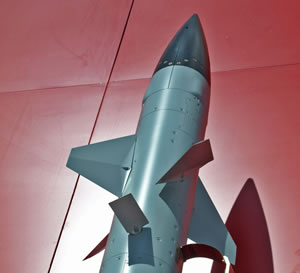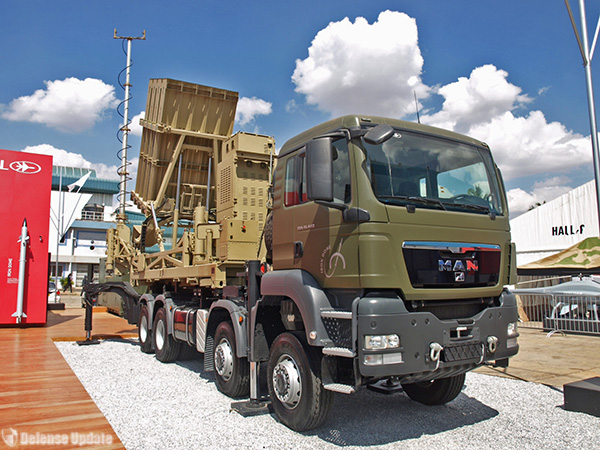

 RAFAEL Advanced defence Systems officially yesterday (February 7, 2013) launched the international campaign offering its combat proven Iron Dome on international markets. Following its brilliant performance intercepting over 500 ballistic rockets in less than a year since the first system deployment, Iron Dome has now become a effective shield, but also providing political means of deterrence, actively used by Israel to signal to its enemies to ‘back off’.
RAFAEL Advanced defence Systems officially yesterday (February 7, 2013) launched the international campaign offering its combat proven Iron Dome on international markets. Following its brilliant performance intercepting over 500 ballistic rockets in less than a year since the first system deployment, Iron Dome has now become a effective shield, but also providing political means of deterrence, actively used by Israel to signal to its enemies to ‘back off’.
Based on initial combat lessons learned through recent conflicts, the Iron Dome system has gone through several evolutionary spirals, improving particular aspects of the radar performance, flexibility of the battle management system and fine tuning of Tamir interceptor missiles – demonstrating the systems’ capability to engage a wider set of targets, including long-range (thus faster) rockets and much slower unmanned aerial vehicles (UAVs).
Israel now has six operational Iron Dome batteries. Initially deployed to protect the area around the Gaza Strip, the mobile batteries are now shifted throughout the country, to beef up protection of specific sites and also as acts of deterrence. Iron Dome batteries to Eilat, facing Sinai, Northern Israel and the Golan Heights signaling the Syrians and Hezbollah that Israel will not tolerate rocket attacks on its territory, even in retaliation to Israeli unilateral actions (such as the alleged attack on the Syrian research center and SA-17 convoy en-route to Lebanon).
As tempting as it would be to repeat the mantra of Iron Dome providing a shield protecting from rocket attacks, this application would be relevant to few customers, that would consider it at a low priority, compared to other high ticket spending. That’s because most countries do not face this type of threats, and if they do, they are not determined to invest what is needed to protect against it (neither did Israel, throughout the early development of Iron Dome). Senior The Indian Air Force officials commented on the system flatly rejected it’s C-RAM value for India “It is a great system but not for India. Our country is larger, and have different needs” a senior Air Force leader told Vayu – Defense-Update. Indian Air Force, Chief Air Marshal A K Browne also said he was briefed on the system two years ago, he said the system is not suitable for his service. Nevertheless, other branches having different missions could have interest in the system.
Yet, when exposed to such threats, becoming strategic, such countries would have loved to have something in their arsenal they could deploy to ‘take care of things’.Iron Dome could certainly become such a tool, if looked at from a different angle. The system was designed to defeat different targets – not only rockets. It carries a relatively large warhead, originally designed to destroy even small targets (like rockets or UAVs). Another distinctive advantage is the flexibility of the system to operate in congested airspace – Iron Dome is also designed to carry out its mission without risking others using it simultaneously. It coexists and safely operates in areas were civil and military aerial traffic mixes, meaning the missile navigates its flight path to avoid collision or damage to other flying objects – except the target. It will therefore avoid UAVs, aerostats, and all friendly, civil or unidentified aircraft.
Current Very Short Range Air Defence systems (VSHORAD) are not offering realistic protection with missiles theoretically having ranges up to 6-7 km (in reality, much less). Such protection is particularly ineffective against stand-off attacks with precision guided weapons, which are becoming the norm in attacking any type of targets.
Contemporary VSHORAD systems have relied on derivatives of Man-Portable Air Defence (missile) Systems (MANPADS) shoulder-fired missiles such as the Stinger, Strela, Igla, Mistral and RBS70 to name a few. All these missiles were designed to conform with weight and safety margins set for the human platform therefore, as air defence effectors they represent a cost-performance compromise that would meet the customer requirements at specific points, but would leave considerable gaps open for exploitation. In fact, most military forces have scaled down the use and replenishment of MANPADS based VSHORAD missiles, as this class of weapons has become increasingly a security
concern, when falling into the wrong hands.
 While their value as defensive weapons is becoming questionable, MANPADS dtill present a very potent weapon in the hands of terrorists. Weapons like the Stinger and advanced STRELA missiles that were looted from military installations in Iraq, Libya and elsewhere have reached terrorists throughout the world, and state suppliers like Iran keep pushing such weapons to more and more organizations. MANPADS have claimed an increasing toll on coalition aircraft operating in Afghanistan and Iraq, and these weapons have also seen operational success in various conflicts throughout central Africa. Iron Dome offers a new solution for VSHORAD, tackling the problem from a new perspective. Unlike the original Iron Dome that was configured to ‘hermetically’ cover a specific sector’. A VSHORAD-configured Iron Dome would employ the same units in a different setup, with a radar, mobile firing units and battle management units that would cover the full 360 degrees hemisphere. RAFAEL has tested the Spyder SR’s using Elta EL/M-2106 for this application. Such radar can detect a wider target set that also includes manned or unmanned aircraft, helicopters, as well as other potential ‘airborne threats’ that might threaten the protected site.
While their value as defensive weapons is becoming questionable, MANPADS dtill present a very potent weapon in the hands of terrorists. Weapons like the Stinger and advanced STRELA missiles that were looted from military installations in Iraq, Libya and elsewhere have reached terrorists throughout the world, and state suppliers like Iran keep pushing such weapons to more and more organizations. MANPADS have claimed an increasing toll on coalition aircraft operating in Afghanistan and Iraq, and these weapons have also seen operational success in various conflicts throughout central Africa. Iron Dome offers a new solution for VSHORAD, tackling the problem from a new perspective. Unlike the original Iron Dome that was configured to ‘hermetically’ cover a specific sector’. A VSHORAD-configured Iron Dome would employ the same units in a different setup, with a radar, mobile firing units and battle management units that would cover the full 360 degrees hemisphere. RAFAEL has tested the Spyder SR’s using Elta EL/M-2106 for this application. Such radar can detect a wider target set that also includes manned or unmanned aircraft, helicopters, as well as other potential ‘airborne threats’ that might threaten the protected site.
Alternatively, a full-scale Elta EL/M-2084 Multi-Mission Radar (MMR) currently supporting enhanced Iron Dome systems could also be used, operated in the rotating, rather than staring mode. The VSHORAD Iron Dome system displayed here at Aero-India 2013 is mounted on a truck flatbed, to easily deploy with moving forces (protecting forward troops in staging areas, deployed command posts or critical communications nodes).
The number of missiles to be carried by each fire unit could be different from today’s 20 pack – and would then be tailored for the mission and tactics, techniques and procedures (TTP) – it could be 10, 20 or any other combination. The mobile Iron-Dome will enable operators to deploy stand-alone air defenses to protect securing specific high-value sites, or fielding the system as part of a multi-layered air defence system, together with existing assets.
A major consideration in the acquisition of new weapon systems is the additional cost and benefit of such systems. When seeking to increase efficiency, planners often look for the least costly means to do the job. Iron Dome was developed to offer the lowest cost per kill in the industry, but this was achieved not as a compromise on essential capabilities or efficiency. In fact, when compared to contemporary VSHORAD alternatives, Iron Dome effectors cost almost five times less while offering much better performance in all relevant terms. Enhanced performance means more efficient battle economy, further contributing to affordability and flexibility in using ones active-defense assets.
In India, RAFAEL is offering Iron Dome as a complementary system to the Spyder SR that has already been selected for the Indian Short Range Surface to Air Missile (SRSAM) system. Along with the Spyder SR’s dual-missile capability (Derby & Python 5) the addition of Iron Dome will expand the multi-layer defensive capability, dramatically increasing target engagement potential, particularly against complex attacks (by multiple types of threats, manned and unmanned). The deployment of multiple types of missiles and engagement techniques would deliver more intercept solutions, further increasing the probability to intercept targets of all types.
















